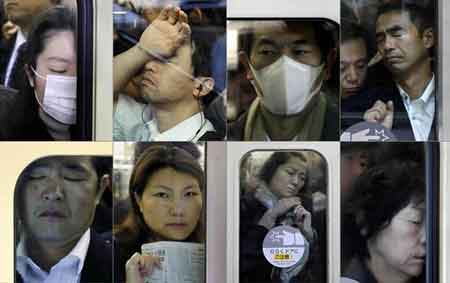 |
|
Packed like sardines into sweaty, claustrophobic carriages, these passengers can barely breathe let alone move about freely. |
|
If you think your commute is a living hell, then spare a thought for these subway passengers in Tokyo. Packed like sardines into sweaty, claustrophobic carriages, these passengers can barely breathe let alone move about freely. The photographs are the work of Michael Wolf, a German-born artist who has been capturing the cramped conditions of the Japanese capital's transport network for 15 years. Tokyo is world famous for its urban density and so the public transport nightmare is hardly surprising. Standing on the platform as the doors snap shut, Wolf has been able to capture a whole range of expressions from his unwilling and trapped subjects. Some stare disconcertingly at the lens, others close their eyes to try and escape the brutal overcrowding, while others have their faces contorted against the steamy glass windows. Wolf first experienced the Japanese subway network when reporting on the aftermath of the sarin nerve gas attack which killed 16 people and injured 6,000 in 1995. His collection of images quickly grew into a portfolio first exhibited in 2008. 'I shot six frames of faces of early morning commuters in subway windows which turned out to be very powerful images,' said Wolf. 'I spent 20 days [Monday to Friday] every morning from 7.30 until 8.45 at the same subway station shooting portraits of people on their way to work.' 'The images create a sense of discomfort as his victims attempt to squirm out of view or simply close their eyes, wishing the photographer to go away,' reads the description on Wolf's website. Eleven million commuters use Tokyo's transport network every morning, with suburban and subway trains reliably packed to the brim from first light to late morning. It is a sign that Tokyo's tsukin jigoku [commuting hell] has grown steadily out of hand that the railway companies have employed white-gloved oshiya (pushers) to shove passengers into carriages since 1955. Regular commuters have become deft at performing what is known as the Tokyo pirouette, which allows them to slide into the carriage and then stand without having to make eye contact with those who have moved aside. Scuffles between frustrated commuters have become more and more common, while notorious chikan [subway molesters] take advantage of the overcrowding to fondle fellow passengers. Passengers are well trained in using whatever they have on them - bags, briefcases and umbrellas, for example - to fight for space. Police have reported a massive rise in 'commuter incidents' - injuries and assaults. (Read by Brian Salter. Brian Salter is a journalist at the China Daily Website.) (Agencies) |
如果你觉得自己的上班路上太拥挤,不妨想想东京地铁上的乘客。车厢内挤得像沙丁鱼罐头一样,汗臭和幽闭的车厢让人几乎无法呼吸,更不用说自如走动了。 这组照片是德国艺术家迈克尔•沃尔夫拍摄的。他花费了15年时间,用镜头记录了东京交通的拥挤状况。 东京是全球闻名的人口高密度城市,因此公共交通拥挤如噩梦一点都不意外。 车厢门一关上,沃尔夫便开始在站台上捕捉人们的丰富表情。乘客通常不愿被拍摄,但也无处挪身。 一些乘客窘迫地盯着镜头,另一些人闭上眼睛试图逃开无情的拥挤场面,还有一些人的脸扭曲地贴在沾满水珠的车厢玻璃窗上。 1995年东京地铁遭遇沙林毒气袭击后,沃尔夫来到东京采访,首次体会到东京地铁的拥挤。那次毒气袭击事件造成16人死亡,六千人受伤。2008年他用这些照片举行了第一次摄影展。 沃尔夫说:“我隔着车窗拍了六组早晨上班族乘地铁的照片,这些照片影响很大。” “我花了20天时间,每周一到周五的早上7时30分到8时45分,在同一个地铁站拍摄那些坐地铁去上班的人。“ “这些照片产生了一些不适感,因为被拍者试图逃避镜头或者只是闭上眼睛,希望拍摄者走开。”沃尔夫在自己网站上这样写道。 每天早晨,东京有1100万人乘坐地铁,从黎明到上午,城铁和地铁都挤得没有一丝缝隙。 东京“通勤地狱”逐渐失控的一个标志就是,早在1955年,东京地铁公司就雇佣了带着白手套的“推手”们,把乘客塞进车厢。 东京上班族纷纷变成挤地铁的高手,可以迅速挤进车厢,还可以仅靠脚尖站立,不与那些被挤到一边的人有任何眼神交流。 地铁乘客之间的争斗也越来越司空见惯,臭名昭著的地铁猥亵者则趁机非礼他人。 “训练有素”的乘客们可以使用手上的各种物品,如背包、公文包、雨伞等来争夺空间。日本警方称,发生在地铁上班族身上的受伤和袭击事件大幅增长。 相关阅读 (中国日报网英语点津 Julie 编辑:陈丹妮) |
|
Vocabulary: spare a thought for: 想到,替某人着想 claustrophobic: 导致幽闭恐怖症的,令人不适地被关闭或被包围的 squirm out of: 逃避 pirouette: (芭蕾舞中的)单脚尖旋转 molester: 猥亵者,性骚扰者 |
